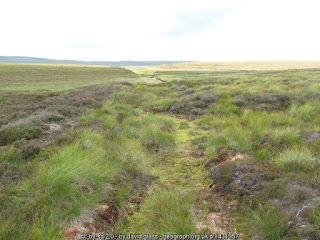Droving
Droving mobs of sheep would have been one of the most
important and time consuming jobs for John.
In early summer, flocks from Langwell would be moved to
Rumsdale perhaps via the old Priests' route.
In autumn the flocks would be driven to the sales at Lairg
and further south. This may have taken several weeks as the sheep, needing to
arrive in well fed condition, would be allowed to graze on the way.
 |
Herdwick sheep crossing Lingcove Bridge.
On John's droving trips he probably
had to ford rivers with his flock frequently
|
My late mother Joy McLeod, great granddaughter of John and
granddaughter of Alexander (aka Sandy) wrote the following remark.
I guess Edinburgh did seem amazing if he had never been there before. It must
have been a very long drove.
There would have been many nights and weeks away from home.
Drovers usually slept out with their mobs of sheep, with
only their plaid (woven cloth) to keep them warm. Sometimes they stayed in
drovers’ inns which also charged for grazing stock. Drovers' food was meagre, oatmeal mixed with
hot or cold water was the staple.
 |
These are cattle drovers but illustrate the use of the plaid.
|
 |
Good sheep dogs were a must.
Sheep dog Buff at work in field at
Rathbaun Farm.
|
The routes taken were well used tracks, preserved by
generations of drovers. They often led across the higher ground of the open
hills and fell sides where free grazing was readily available for the herds.
From Rumsdale to market, the flocks of sheep were moved along the old Ca na
Catanach route, an ancient route to and from Caithness probably in use since
medieval pilgrim times. This old way still exists and it is possible to walk
parts of it easily.
 |
The Ca na
Catanach track which ran
from Thurso to Kinbrace.
|
 |
Drove Road near Rumsdale
A very
old track, used as drove road.
This is a branch of the Ca na Catanach
track
which ran from Thurso to Kinbrace.
|
All the years John McLeod was at Rumsdale, Donald Horne was
his Laird and master. Stories from Badbea indicate that the years between 1830
to 1857 under Donald Horne were very harsh. As well, across Scotland there were
difficult climatic conditions plus the very serious potato blight. There were
epidemics of cholera and typhus. Writing about Donald Horne, Alexander Gunn
uses words like tyranny and oppression and people being driven to a state of
desperation.
The Rumsdale farm results must have been satisfactory to
Horne as year in, year out, for four decades John McLeod was the mainstay and
shepherd at Rumsdale.
Eventually, Donald Horne became financially embarrassed and
had to put the Highlands properties up for sale.
As well the wool price was dropping in England with wool arriving
from the colonies especially New Zealand.
In 1853 Rumsdale was advertised for sale and eventually
changed hands in 1863 to Sir Tollemache Sinclair for £16,500.
Many large sheep farms were being turned into sporting
estates with grand hunting lodges being built for the new owners to hunt deer,
grouse and other game.
 |
The
Dalnawillan Hunting Lodge taken from
the Dalnawillan Cemetery where John
and
Christina are buried.
It is now disused
and boarded up.
|
With the transfer of
Rumsdale farm to Sinclair, so terminated John McLeod’s 41 years as shepherd on
this huge property. John was 68 years old, Christina 65 and both ready to
retire.
 |
The Shepherd by Henry W Kerr
|







No comments:
Post a Comment